仁爱版英语七年级下册 Unit5_Topic2_吃透语法:现在进行时态
- 格式:doc
- 大小:34.50 KB
- 文档页数:2
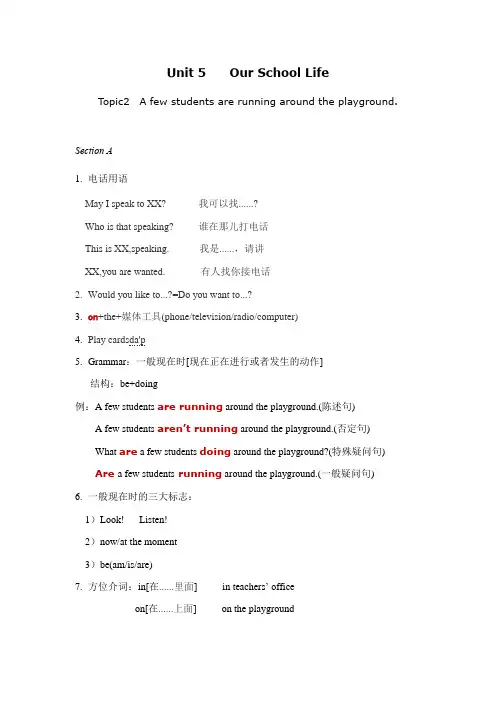
Unit 5 Our School LifeTopic2 A few students are running around the playground.Section A1.电话用语May I speak to XX? 我可以找......?Who is that speaking? 谁在那儿打电话This is XX,speaking. 我是......,请讲XX,you are wanted. 有人找你接电话2.Would you like to...?=Do you want to...?3.on+the+媒体工具(phone/television/radio/computer)4.Play cardsda'p5.Grammar:一般现在时[现在正在进行或者发生的动作]结构:be+doing例:A few students are running around the playground.(陈述句)A few students aren’t running around the playground.(否定句)What are a few students doing around the playground?(特殊疑问句)Are a few students running around the playground.(一般疑问句)6.一般现在时的三大标志:1)Look! Listen!2)now/at the moment3)be(am/is/are)7.方位介词:in[在......里面] in teachers’ officeon[在......上面] on the playgroundSection B1.borrow sth. from sb.2.look for 强调寻找的过程find 强调寻找的结果例:I’m looking for my wallet.(强调过程:正在寻找)I can’t find my wallet.(强调结果:找不到)3.on the shelf (pl. shelves)4.How long can I keep these books? 这些书我能借多久?5.return=give back6.on time 按时in time 及时7.some→any(否定句、一般疑问句)例:Do you have any English newspapers?Sorry, we don’t have any.8.Lost and Found 失物招领Section C1.Thank you all the same. [对方不能提供帮助但仍然表示感谢。
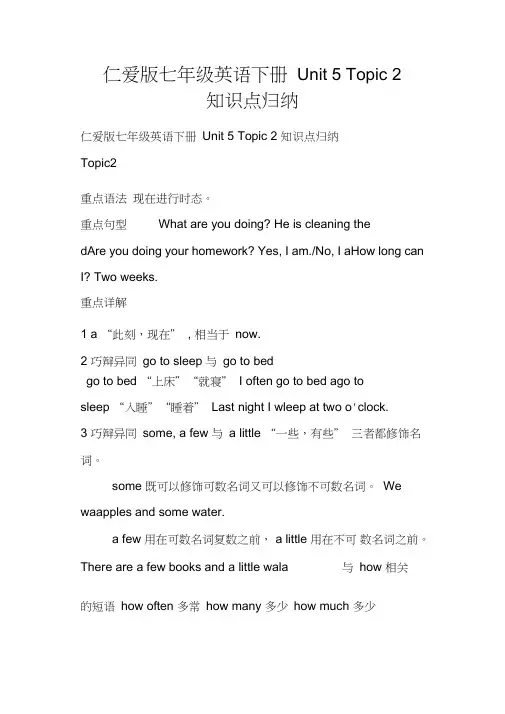
仁爱版七年级英语下册Unit 5 Topic 2知识点归纳仁爱版七年级英语下册Unit 5 Topic 2 知识点归纳Topic2重点语法现在进行时态。
重点句型What are you doing? He is cleaning thedAre you doing your homework? Yes, I am./No, I aHow long can I? Two weeks.重点详解1 a “此刻,现在” , 相当于now.2 巧辩异同go to sleep 与go to bedgo to bed “上床”“就寝” I often go to bed ago tosleep “入睡”“睡着” Last night I wleep at two o'clock.3 巧辩异同some, a few 与a little “一些,有些” 三者都修饰名词。
some 既可以修饰可数名词又可以修饰不可数名词。
We waapples and some water.a few 用在可数名词复数之前,a little 用在不可数名词之前。
There are a few books and a little wala 与how 相关的短语how often 多常how many 多少how much 多少钱how old 多大5 And you must retu 你必须按时归还它们。
Return 意为“归还,回归”retub. 把某物归还某人=give bab.return to “回至U…”,相当于come back to …6 Maria and a girl are talking at the lost and found. talk “交谈”,常用的短语talk to/with sb. “与某人、亠、居”交谈”巧辩异同talk, say, speak 与tell(1) talk “交谈”,表示通过谈话方式交换意见、消息等。
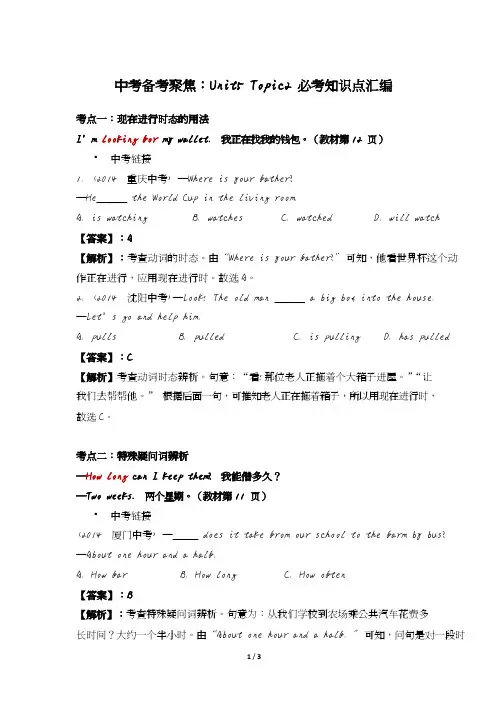
中考备考聚焦:Unit5 Topic2 必考知识点汇编考点一:现在进行时态的用法I’m looking for my wallet. 我正在找我的钱包。
(教材第12 页) 中考链接1. (2014•重庆中考) —Where is your father?—He______ the World Cup in the living room.A. is watchingB. watchesC. watchedD. will watch 【答案】:A【解析】:考查动词的时态。
由“Where is your father?”可知,他看世界杯这个动作正在进行,应用现在进行时。
故选A。
2. (2014•沈阳中考)—Look! The old man ______ a big box into the house. —Let’s go and help him.A. pullsB. pulledC. is pullingD. has pulled 【答案】:C【解析】考查动词时态辨析。
句意:“看!那位老人正拖着个大箱子进屋。
”“让我们去帮帮他。
”根据后面一句,可推知老人正在拖着箱子,所以用现在进行时,故选C。
考点二:特殊疑问词辨析—How long can I keep them? 我能借多久?—Two weeks. 两个星期。
(教材第11 页)中考链接(2014•厦门中考) —_____ does it take from our school to the farm by bus? —About one hour and a half.A. How farB. How longC. How often【答案】:B【解析】:考查特殊疑问词辨析。
句意为:从我们学校到农场乘公共汽车花费多长时间?大约一个半小时。
由“About one hour and a half. ”可知,问句是对一段时间提问。
故选B。
考点三:辨析a few 和fewA few students are running around the playground.有一些学生正在绕着操场跑步. (教材第13 页)中考链接(2014•重庆中考)The girl in purple is new here, so_____ people know her.A. fewB. a fewC. littleD. a little【答案】:A【解析】:考查形容词辨析。
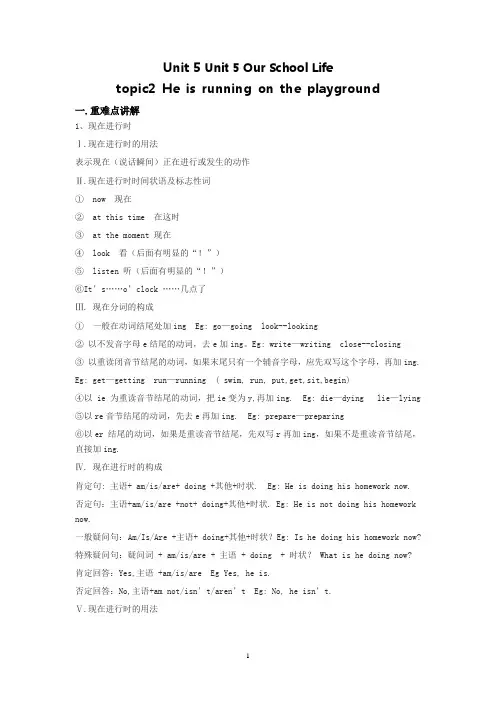
Unit 5 Unit 5 Our School Lifetopic2 He is running on the playground一. 重难点讲解1、现在进行时Ⅰ.现在进行时的用法表示现在(说话瞬间)正在进行或发生的动作Ⅱ.现在进行时时间状语及标志性词① now 现在② at this time 在这时③ at the moment 现在④ look 看(后面有明显的“!”)⑤ listen 听(后面有明显的“!”)⑥It’s……o’clock ……几点了Ⅲ. 现在分词的构成①一般在动词结尾处加ing Eg: go—going look--looking② 以不发音字母e结尾的动词,去e加ing。
Eg: write—writing close--closing③ 以重读闭音节结尾的动词,如果末尾只有一个辅音字母,应先双写这个字母,再加ing. Eg: get—getting run—running ( swim, run, put,get,sit,begin)④以 ie 为重读音节结尾的动词,把ie变为y,再加ing. Eg: die—dying lie—lying⑤以re音节结尾的动词,先去e再加ing. Eg: prepare—preparing⑥以er 结尾的动词,如果是重读音节结尾,先双写r再加ing,如果不是重读音节结尾,直接加ing.Ⅳ. 现在进行时的构成肯定句: 主语+ am/is/are+ doing +其他+时状. Eg: He is doing his homework now.否定句:主语+am/is/are +not+ doing+其他+时状. Eg: He is not doing his homework now.一般疑问句: Am/Is/Are +主语+ doing+其他+时状?Eg: Is he doing his homework now? 特殊疑问句:疑问词 + am/is/are + 主语 + doing + 时状? What is he doing now? 肯定回答:Yes,主语 +am/is/are Eg Yes, he is.否定回答:No,主语+am not/isn’t/aren’t Eg: No, he isn’t.Ⅴ.现在进行时的用法①表示现在或说话时正在进行的动作,常以now, at the moment连用,有时也和look,listen, It’s …… o’clock等连用。
![[精]仁爱版七年级英语下第五单元重点知识点](https://uimg.taocdn.com/3b25cb8fa76e58fafbb0036b.webp)
仁爱版七年级英语下第五单元重点知识点一、时态---现在进行时1.现在分词的构成规则:一般情况下,直接在动词后面加ing 如:read----reading ; drink---drinking ; eat---eating ;动词末尾是e,而且e不发音,去e加ing 如:write ---writing ; make--- making ; ride---riding ;重读闭音节结尾的(不知道什么是重读闭音节,就记作“辅元辅”结构,例如dig,sit,hop这样的,注意中间的元音字母和末尾的元音字母都是一个),双写末尾的辅音字母再加ingsit---sitting ; swim--swimmingput---putting ; run—running以ie结尾的,把ie变y,再加ing:lie -- lyingdie --- dying现在分词变化,没有辅音字母加y这一条!2. 现在进行时标志词:暗示在进行时的时间状语,常用的有:now, at the moment, at this moment ,these days 等;或者交代现在的点钟,也常用用look, listen提醒提醒对方正在发生(这是常考点)。
例如:They are having an English class now.他们正在上英语课。
Listen! Sonebody is ringing the bell.听!有人按门铃。
Look!A lot of children are playing in the park.看! 很多孩子在公园里玩。
He is writing a novel these days.他最近在写一本小说。
(最近一直在做,但此时此刻不一定在写)3.现在进行时的用法a. 表示说话时正在We are talking about the film.我们正在聊这部电影。
b. 表示最近一段时间经常做,但是说话时未必正在做。
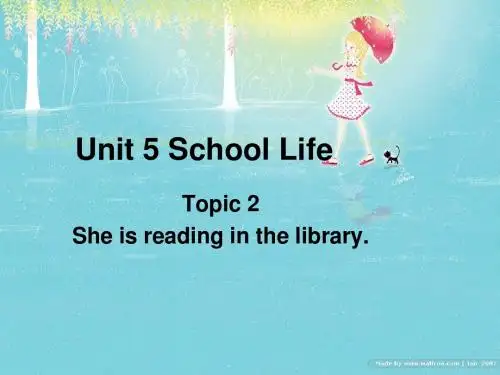
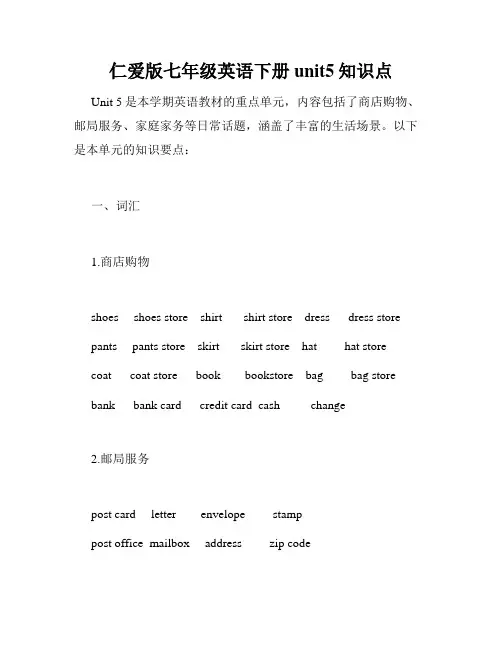
仁爱版七年级英语下册unit5知识点Unit 5是本学期英语教材的重点单元,内容包括了商店购物、邮局服务、家庭家务等日常话题,涵盖了丰富的生活场景。
以下是本单元的知识要点:一、词汇1.商店购物shoes shoes store shirt shirt store dress dress storepants pants store skirt skirt store hat hat storecoat coat store book bookstore bag bag storebank bank card credit card cash change2.邮局服务post card letter envelope stamppost office mailbox address zip code3.家庭家务clean clean up sweep mopwash laundry fold drydish do the dishes set the table clear the table二、重点语法本单元的语法重点是一般现在时和there be句型的运用。
1.一般现在时一般现在时通常用来表示反复发生的动作、习惯性的行为或者现在的状态。
它的构成方式是主语+动词原形+其他。
注意第三人称单数形式应该在动词后面加上“s”。
例如:I often go shopping on weekends. (我经常在周末去购物。
)She always buys books in the bookstore. (她总是在书店买书。
)2.there be句型there be句型用来表示某地或某处有某物。
当表示单数或者不可数名词时,应该用there is;当表示复数名词时,应该用there are。
例如:There is a bank in front of the bookstore. (书店前面有一家银行。
)There are some chairs in the classroom. (教室里有一些椅子。
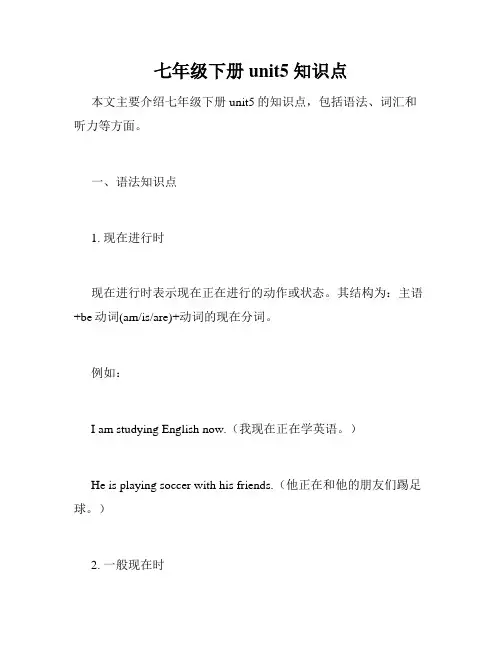
七年级下册unit5 知识点本文主要介绍七年级下册unit5的知识点,包括语法、词汇和听力等方面。
一、语法知识点1. 现在进行时现在进行时表示现在正在进行的动作或状态。
其结构为:主语+be动词(am/is/are)+动词的现在分词。
例如:I am studying English now.(我现在正在学英语。
)He is playing soccer with his friends.(他正在和他的朋友们踢足球。
)2. 一般现在时一般现在时表示目前一直存在或经常发生的动作或状态。
其结构为:主语+动词原形。
例如:I usually go to bed at 10pm.(我通常在晚上10点睡觉。
)She loves reading books.(她喜欢读书。
)3. 一般过去时一般过去时表示过去发生的动作或状态。
其结构为:主语+动词的过去式。
例如:I watched a movie yesterday.(我昨天看了一场电影。
)He visited his grandparents last weekend.(他上周末去看望了他的祖父母。
)二、词汇知识点1. 数字数字在日常生活中非常重要,掌握数字的英文表达可以帮助我们更好地进行交流。
以下是一些常用的数字表达:- 1:one;- 2:two;- 3:three;- 4:four;- 5:five;- 6:six;- 7:seven;- 8:eight;- 9:nine;- 10:ten;- 11:eleven;- 12:twelve;- 13:thirteen;- 14:fourteen;- 15:fifteen;- 16:sixteen;- 17:seventeen;- 18:eighteen;- 19:nineteen;- 20:twenty。
2. 乘客交通工具在生活中我们经常使用各种交通工具,以下是一些常用的乘客交通工具的英文表达:- bus:公交车;- subway/metro:地铁;- taxi/cab:出租车;- train:火车;- plane:飞机;- bicycle/bike:自行车;- motorcycle/bike:摩托车;- car:汽车。
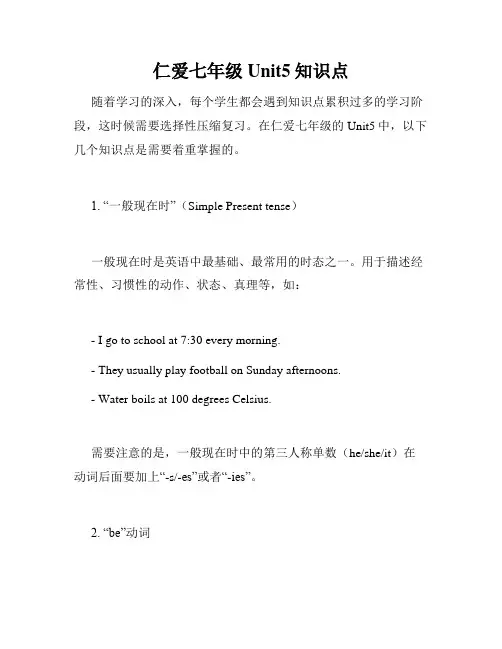
仁爱七年级Unit5知识点随着学习的深入,每个学生都会遇到知识点累积过多的学习阶段,这时候需要选择性压缩复习。
在仁爱七年级的Unit5中,以下几个知识点是需要着重掌握的。
1. “一般现在时”(Simple Present tense)一般现在时是英语中最基础、最常用的时态之一。
用于描述经常性、习惯性的动作、状态、真理等,如:- I go to school at 7:30 every morning.- They usually play football on Sunday afternoons.- Water boils at 100 degrees Celsius.需要注意的是,一般现在时中的第三人称单数(he/she/it)在动词后面要加上“-s/-es”或者“-ies”。
2. “be”动词“be”动词(am/is/are)是英语中最基础、最常用的词之一。
它表示“是、在、存在”的意思,常用于句子的谓语动词,并以各种形式和时间出现:- I am a student.- She is intelligent.- They are playing soccer.需要注意的是,be动词在否定句和疑问句中要发生变化(例如“am not”、“isn't”、“aren't”等),而在以“there”开头的句子中,be 动词要放在“there”后面,以表示“存在”的意思(例如“There is a book on the table.”)。
3. “have”动词“have”动词在现代英语中具有广泛的用途。
它可以作为情态动词使用,也可以表示“拥有、经历、发生”的意思。
它的形式多种多样,如:- I have a pen.- She has a headache.- They have played tennis before.需要注意的是,have动词在否定句和疑问句中也要发生变化(例如“don't have”、“doesn't have”、“haven't”、“hasn't”等)。
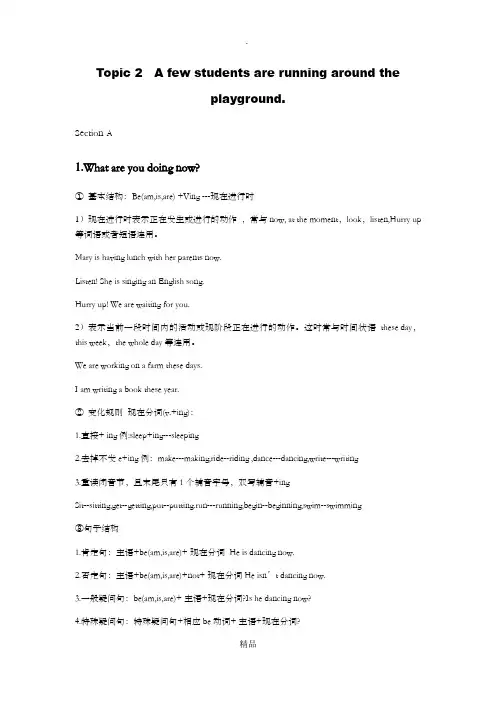
Topic 2 A few students are running around theplayground.Section A1.What are you doing now?①基本结构:Be(am,is,are) +Ving ---现在进行时1)现在进行时表示正在发生或进行的动作,常与now, at the moment,look,listen,Hurry up 等词语或者短语连用。
Mary is having lunch with her parents now.Listen! She is singing an English song.Hurry up! We are waiting for you.2)表示当前一段时间内的活动或现阶段正在进行的动作。
这时常与时间状语these day,this week,the whole day等连用。
We are working on a farm these days.I am writing a book these year.②变化规则现在分词(v.+ing):1.直接+ ing 例:sleep+ing---sleeping2.去掉不发e+ing 例:make---making,ride--riding ,dance---dancing,write---writing3.重读闭音节,且末尾只有1个辅音字母,双写辅音+ingSit--sitting,get--getting,put--putting.run---running,begin--beginning,swim--swimming③句子结构1.肯定句:主语+be(am,is,are)+ 现在分词 He is dancing now.2.否定句:主语+be(am,is,are)+not+ 现在分词 He isn’t dancing now.3.一般疑问句:be(am,is,are)+ 主语+现在分词?Is he dancing now?4.特殊疑问句:特殊疑问句+相应be动词+ 主语+现在分词?What are you doing at themoment? I’m watching TV.[注意]1)be 动词要与主语的人称和数保持一致。

Unit5Our school lifeTopic2 A few students are running around the playground 一.重点语法部分1.现在进行时态:表示正在进行或发生的动作。
现在进行时的构成:是由助动词be(am/is/are)+doing(动词的现在分词)构成句子的谓语。
七主要句型可以归纳为如下几种:(1) 肯定句:主语+be+doing+sth.I am running. You are running. He/She is running.(2)否定句:主语+be+not+doing+sth.I’m not running. You aren’t running. He/She isn’t running (3) 一般疑问句:Be+主语+doing+sth.?回答:Yes,主语(代词)+be./ No,主语(代词)+be+not.—Are you running? —Yes, I am./—No, I am not.—Is he/she running? —Yes, he/she is./ —No. he/she isn’t.(4) 特殊疑问句:疑问词+be+主语+doing+sth.?What are you doing,Jane?2.现在分词的构成规则1) 一般在动词原形末尾ingdrink----drinking buy-----buying call----calling work→ working2) 以不发音e结尾的动词,去e加ingmake→making give-----giving come----coming drive----driving3) 在重读闭音节词中,以一个辅音字母结尾,且这个辅音字母前只有一个元音字母的词,先双写这个辅音字母,再加ingput→ putting plan----planning swim----swimming sit---sitting4) 以ie为重读音节结尾的动词,把ie变为y,再加ing。
现在进行时1.现在进行时表示现在正在进行或发生的动作,也可表示当前一段时间内的活动或现阶段正在进行的动作。
2.现在进行时的肯定句基本结构为be+动词ing.3.现在进行时的否定句在be后加not。
4.现在进行时的一般疑问句把be动词调到句首。
5.现在进行时的特殊疑问的基本结构为:疑问词+ be + 主语+ 动词ing?如:What are you doing?但疑问词当主语时其结构为:疑问词+ be + 动词ing? 如:Who is singing over there?6. 动词加ing的变化规则(1)一般情况下,直接加ing,如:cook-cooking(2)以不发音的e结尾,去e加ing,如:make-making, taste-tasting(3)如果末尾是一个元音字母和一个辅音字母,双写末尾的辅音字母,再加ing,如:run-running, stop-stopping sit-sitting get-getting run-running forget-forgetting begin-beginning(4)以ie结尾的动词,改ie为y加ing ,die--dying lie--lying时间状语:now, look, listen,It’s …o’clck,Ⅰ、写出下列动词的现在分词:play_______ run_______ swim_______ make_______ go_______ study_______ write_______ read_______ have_______ sing_______ dance_______ put_______see_______ buy_______ eat_______ live_______ take_______ come_______get_______ stop_______ sit_______ begin_______ shop_______ chat_______rain_______ take_______ fly_______Ⅱ、用所给的动词的正确形式填空:1. The boy ________ (draw) a picture now.2. Listen .Some girls ________ (sing) in the classroom .3. My mother __________ ( cook )some nice food now.4. What _____ you ______ ( do ) now?5. Look! They _________ (have) an English lesson.6. They ________(not ,water) the flowers now.7. Look! The girls ________________ (dance )in the classroom .8. What is our son doing? She ______ (listen) to music.9. It’s 5 o’clock now. We _____________ (have) supper now10.______Helen____________ (wash) clothes? Yes, she is.Ⅲ. 按要求进行句型转换:1. Look! Lily is dancing.(改为一般疑问句)________________________________________________2. Kate is looking for her watch.(改为否定句)________________________________________________3. Mrs. White is watching TV.(对划线部分提问)________________________________________________4. I am doing homework.(改为否定句)________________________________________________5. They are waiting for you at the library.(就划线部分提问)________________________________________________Ⅳ.填空1. What are you _____ (do) now? I _________ (eat) bread.2. It’s nine o’clock. My father______ (work) in the office.3. Look, the boy____________ (put) the rubbish into the bin.4. ________he______ (clean) the classroom? No, he isn’t. He_________ (play).5. Where is Make? He_________ (run) on the grass.6. Listen, who_________ (sing) in the music room? Oh, Mary_______ (sing) there.Ⅴ.用现在进行时完成下列句子:1.What______you______ (do)?2.I_______ (sing) an English song.3.What________he________ (mend)?4.He_________ (mend) a car.6.______she___________(sit) in the boat?7.______you_____________(ask)questions?8.We_______________(play) games nowUnit5 Our school lifeTopic2 A new student are running around the playgroundⅠ.单项选择。
吃透语法:现在进行时态
概念:现在进行时表示现在(说话瞬间)正在进行或发生的动作
构成:be动词(am, is, are)+动词ing形式
动词ing形式的构成规则
标志词
now现在right now现在,立即
at the moment=now 现在
look看listen听等
例如:
I am cleaning my bedroom now.我正在打扫我的卧室。
Listen! Mary is singing in the classroom.听,玛丽正在教室里面唱歌。
Look! The dog is playing with a ball.看,小狗正在玩球。
We are watching TV at the moment.我们现在正在看电视。
现在进行时的句式及转换:
肯定句:主语+be动词+动词ing形式+其他
否定句:主语+be动词+not+动词ing形式+其他
一般疑问句:be动词+主语+动词ing形式+其他
巧记口诀:
现在进行要注意,有be才有ing, be的形式看主语,双写情况要留意,否定be 后加not,疑问主语前是be。